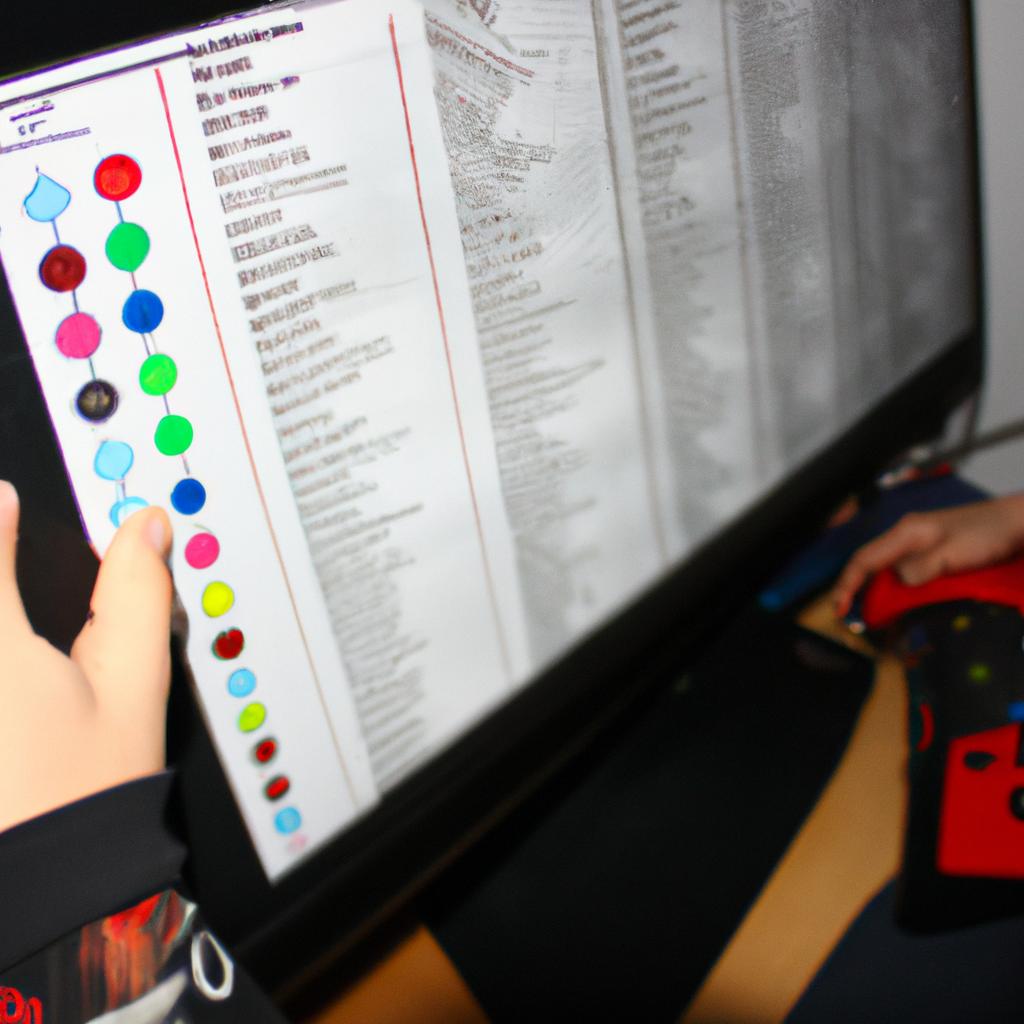Graphics Programming: Enhancing Game Development with Stunning Visuals

Graphics programming plays a crucial role in enhancing the overall visual appeal and immersive experience of modern game development. By harnessing advanced rendering techniques, such as real-time shading, lighting simulations, and post-processing effects, developers can create stunning visuals that captivate players and bring virtual worlds to life. For instance, imagine a hypothetical scenario where a game developer wants to create a realistic open-world environment set in a sprawling cityscape teeming with detail. Through the utilization of graphics programming techniques, they can construct highly detailed buildings with intricate textures, implement dynamic weather systems that affect lighting conditions, and incorporate particle effects for realistic smoke or explosions.
To achieve such remarkable visuals, graphics programmers employ various tools and technologies that enable them to manipulate geometry, apply complex shaders, and optimize performance. One fundamental aspect of graphics programming is understanding how computer hardware interacts with software algorithms to render images efficiently. This involves knowledge of GPU architecture and parallel processing techniques to distribute computations across multiple cores effectively. Furthermore, graphics programmers must possess proficiency in coding languages specifically designed for graphical applications like OpenGL or DirectX.
In this article, we will delve into the world of graphics programming and explore its significance in enhancing game development through visually striking aesthetics. We will discuss the key concepts behind real-time rendering techniques and examine their impact on the overall gaming experience. From understanding the basics of vertex and fragment shaders to exploring advanced techniques like ray tracing and global illumination, we will uncover the secrets behind creating stunning visuals in modern games.
Additionally, we will explore the role of graphics APIs (Application Programming Interfaces) such as DirectX and Vulkan in facilitating efficient communication between software and hardware, enabling developers to take full advantage of the capabilities of modern GPUs. We’ll also discuss how graphics programming extends beyond just game development, with applications in fields like computer-aided design (CAD), virtual reality (VR), and augmented reality (AR).
Throughout this article, we will provide practical examples and code snippets to illustrate key concepts, allowing aspiring graphics programmers to get hands-on experience with implementing various rendering techniques. Whether you’re a seasoned developer looking to expand your skillset or a newcomer interested in diving into the exciting world of graphics programming, this article aims to provide valuable insights and resources for mastering this essential aspect of game development.
So join us as we embark on an exploration of graphics programming, where artistry meets technology to create visually breathtaking experiences that push the boundaries of what is possible in interactive entertainment.
Understanding the Basics of Graphics Programming
Understanding the Basics of Graphics Programming
Imagine playing a video game with stunning visuals that transport you into a captivating virtual world. Have you ever wondered how these incredible graphics are created? This section aims to provide an overview of the basics of graphics programming, shedding light on the fundamental concepts and techniques used to enhance game development with visually appealing elements.
To begin understanding graphics programming, it is essential to grasp the concept of rendering. Rendering refers to the process of generating images from 2D or 3D models using computer algorithms. It involves transforming mathematical representations of objects into visual output, which can then be displayed on a screen in real-time. By leveraging various rendering techniques, developers have the power to create lifelike environments and breathtaking visual effects.
One key aspect of graphics programming is shaders – small programs written by developers to control different aspects of rendering. Shaders play a crucial role in determining how light interacts with surfaces, resulting in realistic reflections, shadows, and textures within a game environment. Additionally, they allow for complex visual manipulations such as particle effects and post-processing filters that add depth and immersion to the gaming experience.
To better understand the impact of graphics programming on game development, let’s consider some key benefits:
- Immersive Gameplay: Stunning visuals draw players deeper into the gaming world, increasing their engagement and enjoyment.
- Realistic Environments: Detailed graphics help create believable settings that enhance storytelling and player immersion.
- Emotional Engagement: Visuals can evoke strong emotional responses by effectively conveying mood and atmosphere through lighting, colors, and animations.
- Competitive Edge: Games with exceptional graphical quality tend to attract more attention from players and reviewers alike.
| Benefits of Graphics Programming |
|---|
| Immersive Gameplay |
By harnessing the power of modern graphics programming techniques, game developers can elevate the visual quality of their creations to new heights. In the subsequent section, we will delve into the role of shaders in game visuals and explore how they contribute to creating stunning graphics that captivate players.
Transition: Now that we have established a foundation on understanding graphics programming, let’s explore the role of shaders in enhancing game visuals.
Exploring the Role of Shaders in Game Visuals
Having gained a foundational understanding of the basics of graphics programming, we now delve into an essential component that enhances game visuals – shaders. By utilizing specialized scripts that define how light interacts with objects in a virtual environment, developers can craft stunning visual effects and elevate the overall aesthetic appeal of their games.
Shaders serve as a bridge between the mathematical calculations required for realistic lighting and the visual representation on screen. Let’s consider a hypothetical scenario where an indie game developer wants to create a visually striking scene featuring water reflections. Through the use of shaders, they can simulate accurate reflection behaviors by manipulating pixel colors based on various environmental factors such as light intensity and object angles. This allows for dynamic rendering of lifelike ripples and distortions, immersing players within the virtual world.
To grasp the significance of shaders further, let’s examine some key roles they play in enhancing game visuals:
- Realistic Lighting: Shaders enable developers to implement advanced lighting models, such as physically-based rendering (PBR). By simulating real-world materials’ response to light sources, PBR shaders contribute to more convincing shadows, reflections, and highlights.
- Post-processing Effects: With shaders, post-processing effects like motion blur or depth-of-field can be applied selectively to specific areas or objects in a scene. These effects add depth and cinematic quality to gameplay experiences.
- Visual Style Customization: Shaders allow developers to create unique art styles by altering color palettes or applying artistic filters. From retro pixelated aesthetics to vibrant cel-shaded worlds, these customizations enhance immersion while fostering creativity.
- Performance Optimization: Utilizing shader techniques such as level-of-detail adjustments or dynamically reducing GPU load during less important scenes helps maintain smooth frame rates without sacrificing graphical fidelity.
Incorporating shaders into game development opens up endless possibilities when it comes to crafting visually stunning experiences. By harnessing the power of these scripts, developers can create games that captivate players and bring their creative visions to life.
Having explored shaders’ role in enhancing game visuals, let’s now turn our attention to utilizing lighting techniques for achieving realistic graphics.
Utilizing Lighting Techniques for Realistic Graphics
Building upon our understanding of game visuals, let us delve into how shaders play a vital role in enhancing graphics. One intriguing example that showcases the power of shaders is the popular open-world action-adventure game, “The Witcher 3: Wild Hunt.” In this game, detailed landscapes and realistic character models are achieved through the clever utilization of various shader techniques.
Shaders serve as programs written to manipulate graphical elements within a game environment. They allow developers to control lighting effects, textures, shadows, and post-processing filters with precision. By altering these parameters dynamically during runtime, games can achieve stunning visual fidelity and create immersive experiences for players.
To highlight the versatility and impact of shaders in game development, here are some key aspects worth exploring:
- Lighting Effects: Shaders enable the simulation of different types of lighting conditions such as ambient light, point lights, directional lights, and spotlights. This flexibility allows designers to set specific moods or atmospheres by adjusting color intensity, shadowing effects, and more.
- Realistic Textures: With shaders, developers can apply intricate texture maps onto objects and characters within a game world. These textures simulate surfaces like wood grain or fabric patterns convincingly.
- Dynamic Shadows: Shaders help generate dynamic shadows that react accurately to changes in light sources’ positions or movements. This adds depth and realism by casting appropriate shadows on nearby objects.
- Post-Processing Filters: Shaders also contribute to post-processing effects like motion blur, bloom, depth-of-field focus effects, and color grading. These techniques enhance immersion by mimicking real-life camera aesthetics or adding stylized visual flair.
By harnessing these shader capabilities effectively in their games’ rendering pipelines, developers have revolutionized the gaming industry’s visual standards.
Transitioning seamlessly into our next topic – Utilizing Lighting Techniques for Realistic Graphics – we will explore how lighting techniques further contribute to creating lifelike visuals in games. Through careful manipulation of shaders and the clever use of lighting models, developers can achieve remarkable realism that captivates players.
Optimizing Performance in Graphics Programming requires a balanced approach to ensure smooth gameplay experiences while maintaining stunning visuals.
Optimizing Performance in Graphics Programming
Building upon the foundation of lighting techniques, we now delve into optimizing performance in graphics programming. By implementing efficient strategies, developers can ensure smooth gameplay experiences without compromising on stunning visuals.
To illustrate the significance of performance optimization, let us consider a hypothetical scenario involving an open-world exploration game with vast landscapes and intricate details. In this case, players are immersed in a visually rich environment where every frame needs to be rendered seamlessly. However, poor performance can result in choppy frame rates that hinder the overall gaming experience.
In order to overcome these challenges and provide players with fluid gameplay, developers can employ various optimization techniques:
-
Level-of-Detail (LOD) Systems: Implementing LOD systems allows for dynamically adjusting the level of detail based on distance or screen space occupancy. By utilizing lower-resolution models or textures as objects move farther away from the camera, unnecessary computational overhead is reduced while still maintaining visual fidelity.
-
Occlusion Culling: By selectively rendering only what is visible within the player’s view frustum, occlusion culling significantly improves performance. This technique minimizes rendering calculations for objects obstructed by others or located outside the camera’s field of vision.
-
Batch Rendering: Grouping similar geometry together and submitting them as a single draw call reduces CPU overhead associated with state changes between render calls. Efficient batch rendering optimizes how objects are rendered by minimizing redundant computations and enhancing GPU utilization.
-
Texture Compression: Utilizing texture compression algorithms such as ASTC or BCn formats reduces memory consumption and bandwidth requirements without sacrificing image quality. Compressed textures allow for more efficient storage and transfer of data, enabling smoother gameplay even on devices with limited resources.
Implementing these optimization techniques not only enhances the overall performance but also ensures that gamers have uninterrupted access to immersive worlds filled with stunning visuals.
Moving forward, we will explore another crucial aspect related to graphics programming: implementing advanced textures and materials. This next section will delve into techniques that add depth, realism, and uniqueness to game environments, further enhancing the visual experience for players.
Implementing Advanced Textures and Materials
Imagine a fantasy role-playing game set in a dark and mysterious forest. As the player explores this virtual world, they are immersed in an atmosphere filled with eerie shadows, flickering torches, and rays of sunlight piercing through dense foliage. These captivating visuals are made possible by implementing advanced lighting techniques in graphics programming. By effectively utilizing various lighting models and algorithms, developers can elevate the visual experience for gamers.
To enhance the realism and aesthetics of gaming environments, several key considerations come into play:
- Global Illumination: Implementing global illumination techniques allows light to interact realistically with objects in the scene, creating lifelike reflections, refractions, and soft shadows. This adds depth and richness to the overall visual presentation.
- Dynamic Lighting: Real-time dynamic lighting enables interactive changes in lighting conditions based on gameplay events or time of day. Whether it’s simulating a sunrise casting warm hues across landscapes or a sudden thunderstorm dimming ambient light levels, dynamic lighting enhances immersion and creates engaging experiences.
- Physically Based Rendering (PBR): PBR is a technique that accurately represents how light interacts with different materials in real life. By incorporating realistic material properties such as roughness, metallicity, and transparency into rendering algorithms, developers can achieve highly detailed textures that respond convincingly to changing lighting conditions.
- Post-Processing Effects: Applying post-processing effects like bloom, motion blur, depth-of-field, and color grading add cinematic qualities to games while enhancing their visual impact.
Embracing these advanced lighting techniques not only elevates the quality of visuals but also provides artists and designers greater creative control over a game’s atmosphere and mood.
By harnessing the power of algorithms, developers can create seemingly endless landscapes, intricate dungeons, and diverse ecosystems that captivate players’ imagination.
Creating Immersive Environments with Procedural Generation
Building upon the implementation of advanced textures and materials, game developers can further enhance player experiences by creating immersive environments through procedural generation. This technique allows for dynamic and diverse worlds to be generated in real-time, providing players with unique gameplay experiences each time they interact with the game.
To illustrate the impact of procedural generation on game development, let’s consider a hypothetical scenario where a developer is working on an open-world fantasy role-playing game. Instead of manually designing every aspect of the game world, such as terrain, vegetation, and architectural structures, the developer incorporates procedural generation techniques. By defining rules and algorithms that govern these elements’ creation, the game engine generates vast landscapes filled with lush forests, towering mountainscapes, and ancient ruins teeming with detail.
Procedural generation offers several benefits that contribute to creating immersive environments:
- Infinite Variety: With procedurally generated content, games can offer virtually unlimited possibilities for exploration. Each playthrough becomes a unique experience as new terrains, dungeons, or hidden treasures are dynamically created.
- Time Efficiency: Rather than spending countless hours handcrafting every minute detail within the game world, developers can utilize procedural generation to generate large-scale environments quickly. This allows more time for refining other aspects of gameplay and storytelling.
- Player Engagement: The unpredictability brought forth by procedural generation keeps players engaged and curious about what lies beyond each corner. The sense of discovery fosters replayability and encourages players to explore different paths throughout their gaming journey.
- Scalability: Procedural generation enables developers to create expansive worlds without compromising performance or storage requirements. As players traverse through various regions seamlessly, the game adapts and generates content based on their actions or progress.
To further understand the implications of procedural generation in game development, consider the following table showcasing its potential applications:
| Application | Description | Emotional Response |
|---|---|---|
| World Creation | Dynamically generate diverse landscapes and biomes. | Sense of wonder and awe |
| Dungeon Generation | Create intricate dungeons with unique layouts and challenges. | Excitement and anticipation |
| Quest Variation | Generate a wide range of quests with different objectives. | Curiosity and motivation |
| Item Randomization | Distribute loot and rewards throughout the game world. | Thrill of discovery |
Incorporating procedural generation techniques into game development not only empowers developers to create immersive environments but also enhances player experiences by offering endless possibilities for exploration, engagement, and surprise. By leveraging algorithms to dynamically generate terrains, structures, and gameplay elements, games can captivate players’ attention while ensuring scalability and efficient use of resources. Embracing this powerful tool opens up new avenues for creativity within the gaming industry.









